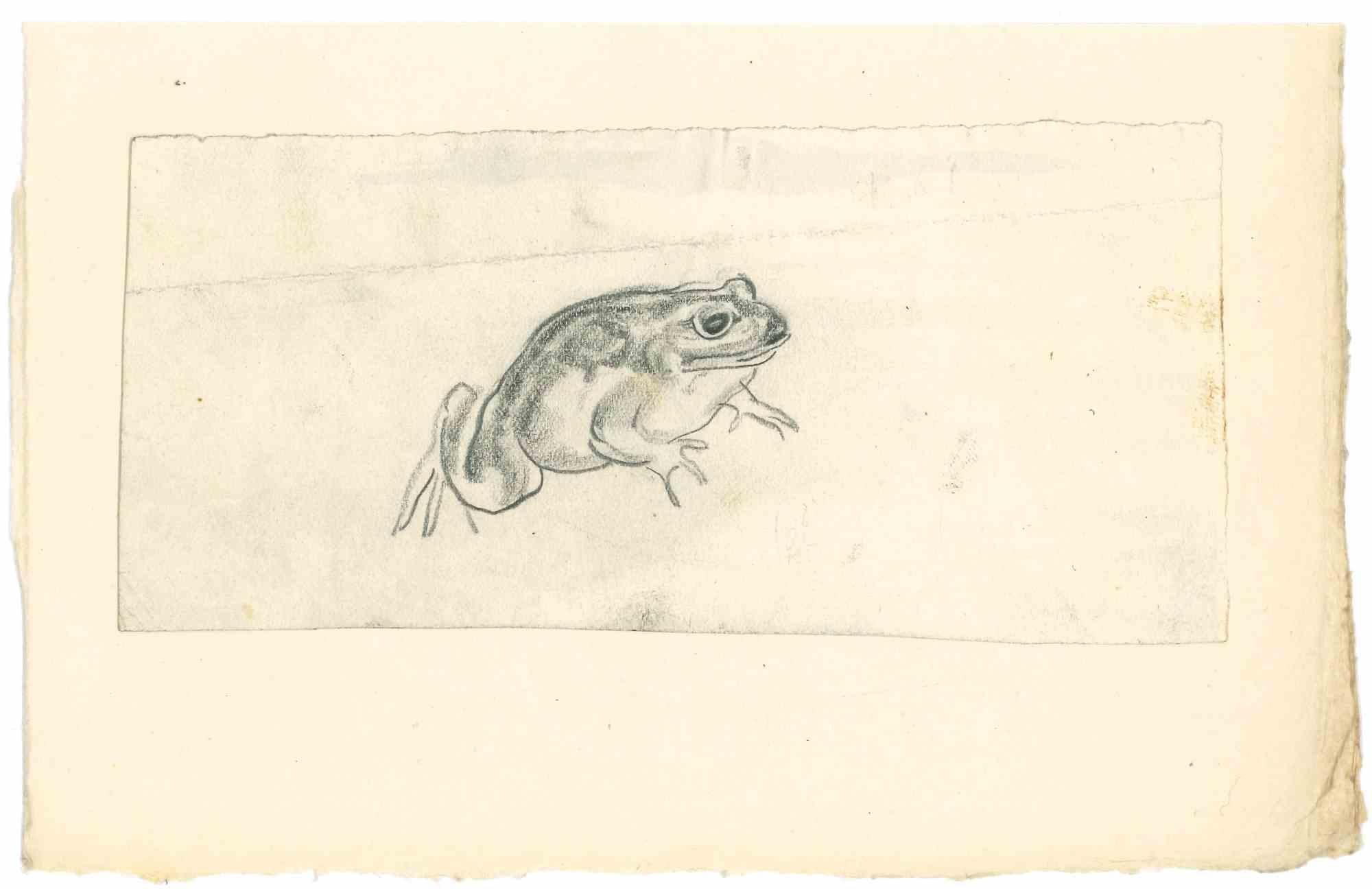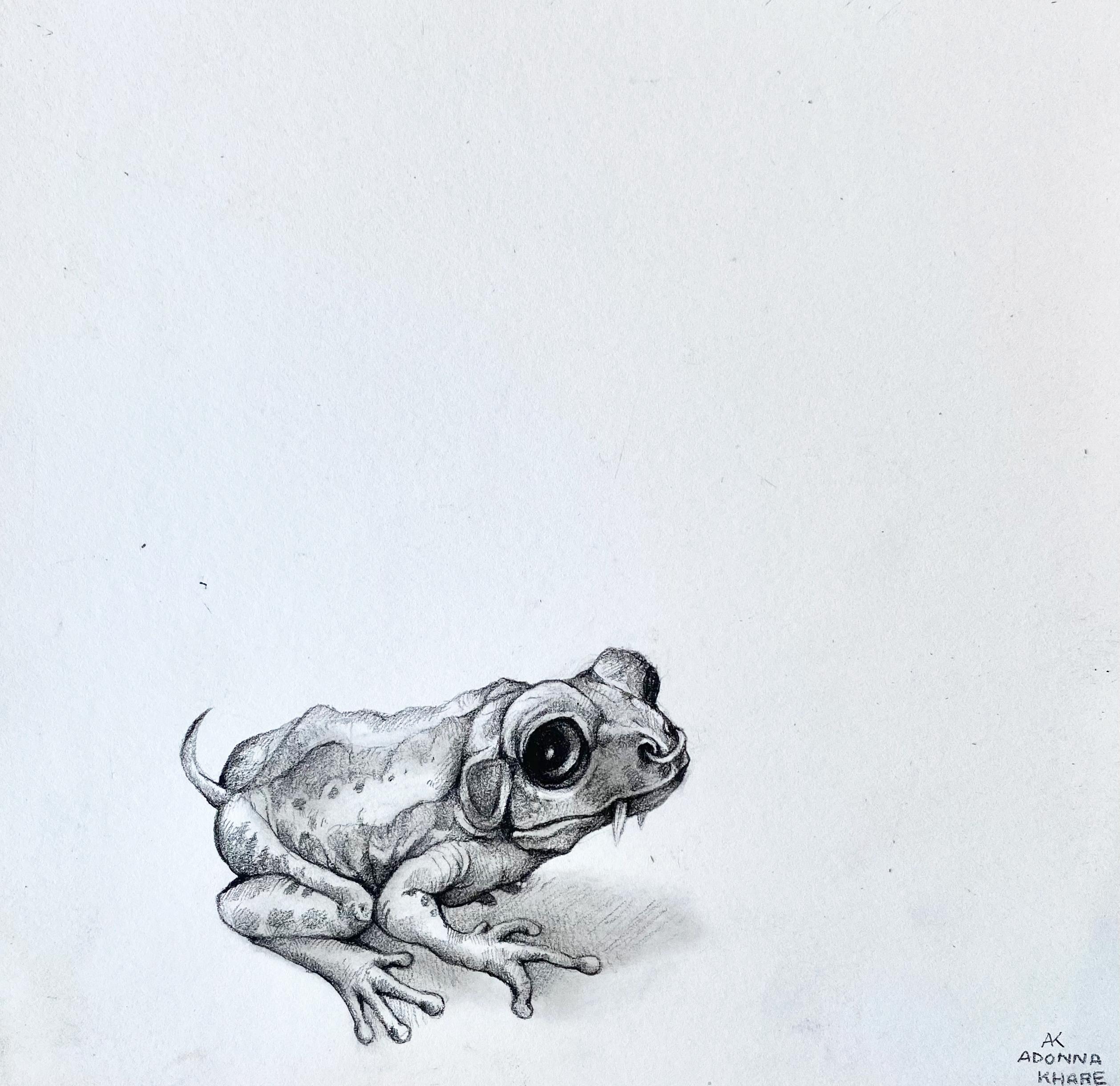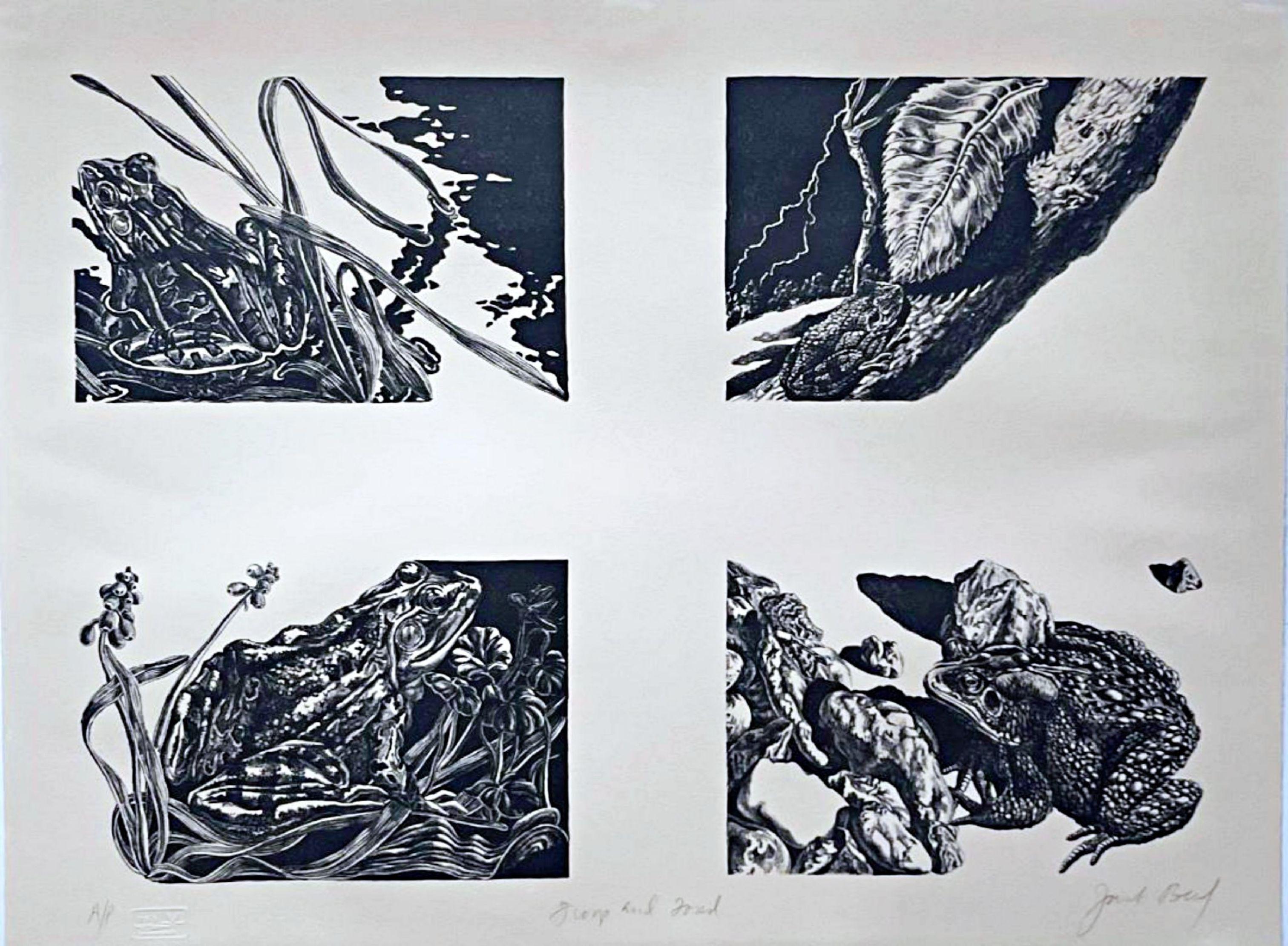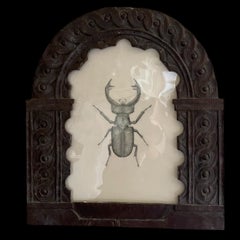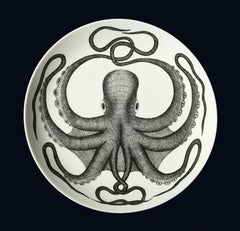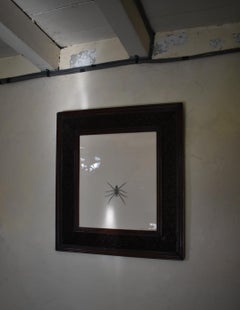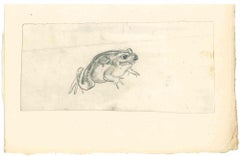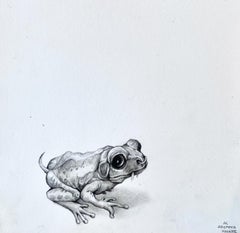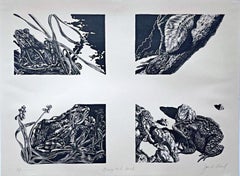Items Similar to Homage to a toad - underglaze pencil on ceramic
Want more images or videos?
Request additional images or videos from the seller
1 of 5
Tom RoothHomage to a toad - underglaze pencil on ceramic2023
2023
$3,439.64
£2,495
€2,913.53
CA$4,755.91
A$5,221.39
CHF 2,724.01
MX$63,186.13
NOK 34,141.26
SEK 32,170.05
DKK 21,748.69
About the Item
This work was created by Tom Rooth in the Cambrian Mountains of Wales.
A colony of toads live under and around his cottage, and in the summer nights (particularly when going to the kiln late at night to close the vent), Tom often encounters them. They have lived there for generations.
Production process:
Tom makes the ceramic panel, which then dries for a month. After this, he carves it down, and then it goes into the kiln for a 48 hour cycle firing.
Tom then draws onto the panel, with underglaze pencils, and then glazes the artwork which goes into the kiln once more, for another 48 hour firing cycle. It is then ready for the frame (the frame dictates the subject-matter).
Tom has an expert knowledge of frames - his parents were framers and restorers, and he worked at Christie's as Senior Picture Specialist and Director for 14 years, and prior to this Bonhams, Phillips and Sotheby's.
Tom's works are unique, highly decorative, highly original, and will compliment any interior, whether traditional or contemporary. Tom has exhibited at The Treasure House Fair (formerly Masterpiece), as well as The Decorative Fair. In 2022 he was commissioned by Eon Productions to produce an Octopussy plate, to celebrate 60 years of James Bond.
Tom lives off-grid in the Cambrian Mountains of Wales, where he produces his art.
- Creator:Tom Rooth (1974)
- Creation Year:2023
- Dimensions:Height: 9.38 in (23.8 cm)Width: 7.64 in (19.4 cm)
- More Editions & Sizes:frame 36.6 x 29.8 cm.Price: $3,440
- Medium:
- Movement & Style:
- Period:
- Condition:
- Gallery Location:London, GB
- Reference Number:1stDibs: LU806113252202
About the Seller
5.0
Gold Seller
Premium sellers maintaining a 4.3+ rating and 24-hour response times
Established in 2016
1stDibs seller since 2017
29 sales on 1stDibs
Typical response time: 4 hours
- ShippingRetrieving quote...Shipping from: London, United Kingdom
- Return Policy
Authenticity Guarantee
In the unlikely event there’s an issue with an item’s authenticity, contact us within 1 year for a full refund. DetailsMoney-Back Guarantee
If your item is not as described, is damaged in transit, or does not arrive, contact us within 7 days for a full refund. Details24-Hour Cancellation
You have a 24-hour grace period in which to reconsider your purchase, with no questions asked.Vetted Professional Sellers
Our world-class sellers must adhere to strict standards for service and quality, maintaining the integrity of our listings.Price-Match Guarantee
If you find that a seller listed the same item for a lower price elsewhere, we’ll match it.Trusted Global Delivery
Our best-in-class carrier network provides specialized shipping options worldwide, including custom delivery.More From This Seller
View AllDeath's head moths under a full-moon, presented in a hand-carved c1880 oak frame
By Tom Rooth
Located in London, GB
'Death's head moths under a full-moon' work was created by Tom Rooth in the Cambrian Mountains of Wales.
Production process:
Tom makes the ceramic panel, which then dries for a month. After this, he carves it down, and then it goes into the kiln for a 48 hour cycle firing.
Tom then draws onto the panel, with underglaze pencils, and then glazes the artwork which goes into the kiln once more, for another 48 hour firing cycle. It is then ready for the frame (the frame dictates the subject-matter).
Kintsugi is a 15th-Century practice invented in Japan, and means 'to join with gold'. The practice is a reminder to embrace flaws, and celebrate the missteps of life, recognising that when seemingly catastrophic events happen, beauty and good can still result.
Tom has an expert knowledge of frames - his parents were framers and restorers, and he worked at Christie's as Senior Picture Specialist and Director for 14 years, and prior to this Bonhams, Phillips and Sotheby's.
Tom's works are unique, highly decorative, highly original, and will compliment any interior, whether traditional or contemporary. Tom has exhibited at The Treasure House...
Category
2010s Realist Mixed Media
Materials
Ceramic, Glaze, Pencil
Stag beetle, presented in an English, 17th Century hand-carved oak frame
By Tom Rooth
Located in London, GB
This work was created by Tom Rooth in the Cambrian Mountains of Wales, where Tom lives, off-grid.
Production process:
Tom makes the ceramic panel, which then dries for a month. After this, he carves it down, and then it goes into the kiln for a 48 hour cycle firing.
Tom then draws onto the panel, with underglaze pencils, and then glazes the artwork which goes into the kiln once more, for another 48 hour firing cycle. It is then ready for the frame (the frame dictates the subject-matter).
Tom has an expert knowledge of frames - his parents were framers and restorers, and he worked at Christie's as Senior Picture Specialist and Director for 14 years, and prior to this Bonhams, Phillips and Sotheby's.
Tom's works are unique, highly decorative, highly original, and will compliment any interior, whether traditional or contemporary. Tom has exhibited at The Treasure House...
Category
2010s Realist Mixed Media
Materials
Ceramic, Glaze, Pencil
Octoplate
By Tom Rooth
Located in London, GB
The Octopussy
with signature on the suckers, and the artist's thumbprint (on the reverse)
screenprint on earthenware, with underglaze paint
37 cm. (14 ½ ) diam.
6.1 cm. (2 ⅜ in....
Category
2010s Realist More Art
Materials
Ceramic, Paint
A giant house spider, in a hand-carved spiderweb patterned frame, circa 1880
By Tom Rooth
Located in London, GB
This is a unique and unusual work, by artist Tom Rooth. The spider is drawn with underglaze pencils (pencils made out of ceramic), on a handmade ceramic panel.
The handmade frame, wh...
Category
2010s Contemporary Mixed Media
Materials
Ceramic, Pencil
Turtle traffic
By Tom Rooth
Located in London, GB
with signature (on a turtle swimming in the opposite direction), and the artist's thumbprint (on the reverse)
screen print on earthenware, with underglaze paint
37 cm. (14 ½ ) diam...
Category
2010s Realist More Art
Materials
Ceramic
Bee columns, in a water-gilded frame, circa 1870
By Tom Rooth
Located in London, GB
This work was created by Tom Rooth in the Cambrian Mountains of Wales.
Production process:
Tom makes the ceramic panel, which then dries for a month. After this, he carves it down, and then it goes into the kiln for a 48 hour cycle firing.
Tom then draws onto the panel, with underglaze pencils, and then glazes the artwork which goes into the kiln once more, for another 48 hour firing cycle. It is then ready for the frame. Tom has an expert knowledge of frames - his parents were framers and restorers, and he worked at Christie's as Senior Picture Specialist and Director for 14 years.
Tom's works are unique, highly decorative, highly original, and will compliment any interior, whether traditional or contemporary. Tom has exhibited at The Treasure House...
Category
2010s Realist Mixed Media
Materials
Ceramic, Glaze, Pencil
You May Also Like
Frog - Drawing in pencil by Emmanuel Gondouin - 1930s
Located in Roma, IT
Frog is a drawing in pencil realized in the early 1930s by Emmanuel Gondouin, (Versailles, 1883 - Parigi, 1934)
The artwork is depicted through strong strokes.
Emmanuel Gondouin is a French Cubist...
Category
1930s Modern Figurative Drawings and Watercolors
Materials
Pencil
Toothy Frog
By Adonna Khare
Located in Bozeman, MT
This is a unframed original drawing on paper. Adonna Khare is an America Artist mainly focused on carbon pencil on paper drawings. She received her Masters of Fine Art from Californi...
Category
2010s Photorealist Animal Drawings and Watercolors
Materials
Archival Paper, Carbon Pencil
Frogs and Toad, Signed lithograph (AP), from Conspiracy: The Artist as Witness
By Jack Beal
Located in New York, NY
Jack Beal
Frogs and Toad, 1971
Hand signed in pencil by Jack Beal, annotated AP
One-color lithograph proofed by hand and pulled by machine from a zinc plate on Arches buff paper with deckled edges at the Shorewood Bank Street Atelier
Stamped, hand numbered AP, aside from the regular edition of 150 Stamped on reverse: COPYRIGHT © 1971 BY JACK BEAL, bears blind stamp
18 × 24 inches
Unframed
18 x 24 inches
Stamped on reverse: COPYRIGHT © 1971 BY JACK BEAL, bears distinctive blind stamp of publisher (shown) Publisher: David Godine, Center for Constitutional Rights, Washington, D.C.
Jack Beal's "Frogs and Toads" is a classic example of protest art from the early 1970s - the most influential era until today. This historic graphic was created for the legendary portfolio "CONSPIRACY: the Artist as Witness", to raise money for the legal defense of the Chicago 8 - a group of anti-Vietnam War activists indicted by President Nixon's Attorney General John Mitchell for conspiring to riot during the 1968 Democratic National Convention. (1968 was also the year Bobby Kennedy was killed and American casualties in Vietnam exceeded 30,000.) The eight demonstrators included Abbie Hoffman, Jerry Rubin, David Dellinger, Tom Hayden, Rennie Davis, John Froines, Lee Weiner, and Bobby Seale. (The eighth activist, Bobby Seale, was severed from the case and sentenced to four years for contempt after being handcuffed, shackled to a chair and gagged.) Although Abbie Hoffman would later joke that these radicals couldn't even agree on lunch, the jury convicted them of conspiracy, with one juror proclaiming the demonstrators "should have been shot down by the police." All of the convictions were ultimately overturned by the 7th Circuit Court of Appeals.
This lithograph has fine provenance: it comes directly from the original Portfolio: "Conspiracy The Artist as Witness" which also featured works by Alexander Calder, Nancy Spero and Leon Golub, Romare Bearden Sol Lewitt, Robert Morris, Claes Oldenburg, Larry Poons, Peter Saul, Raphael Soyer and Frank Stella - as well as this one by Jack Beal. It was originally housed in an elegant cloth case, accompanied by a colophon page. This is the first time since 1971 that this important work has been removed from the original portfolio case for sale. It is becoming increasingly scarce because so many from this edition are in the permanent collections of major museums and institutions worldwide.
Jack Beal wrote a special message about this work on the Portfolio's colophon page. It says, "In 1956, shortly after Sondra and I moved to New York, two friends were arrested and jailed for protesting air-raid drills. From them and their friends came our education. This work is dedicated to them and their families. "In Memory of Patricia McClure Daw and AL Uhrie" - This print was made for their children.
Jack Beal Biography:
Early in his career Walter Henry “Jack” Beal Jr. painted abstract expressionist canvases, because he believed it was “the only valid way to paint.” By the early 1960s he totally altered his approach and fully repudiated abstraction. Turning to representation, he painted narrative and figurative subjects, often enhanced by bright colors and dramatic perspectives.
Beal was born in Richmond, Virginia, and from 1950 to 1953 he attended the Norfolk Division of William and Mary College Polytechnic Institute, (now Old Dominion University) where he studied biology and anatomy. Shifting gears, he sought art training at the School of the Art Institute of Chicago where he focused on drawing, and met his wife, artist Sondra Freckelton. His art history instructor encouraged her students to paint in the manner of established artists, and to that end he frequented the Institute’s galleries. For Beal this was significant: “Until I saw pictures of real quality I had tended to think of painting as just so much self-indulgent smearing around, but when I saw masterpieces by Cézanne and Matisse, and other painters of similar stature, I was bowled over; suddenly I realized the force of art.”
After spending three years (1953–1956) at the Art Institute, Beal concluded his studies there without getting a terminal degree, thinking it was only useful if he wanted to teach, which, at the time, he did not. He also took courses at the University of Chicago in 1955 and 1956. During this period he married Freckelton, a fellow student and sculptor who began her career working in wood and plastic. Together they moved to New York’s SoHo District before its transformation from a wasteland of sweatshops and small factories into an arts district. They were active with the Artist Tenants Association which was instrumental in getting zoning laws changed so that artists could live and work in the well-lit lofts.
Embracing what came to be called “New Realism,” Beal initially painted an occasional landscape as well as earthy-toned still lifes which consisted of jumbled collections filled with personal objects. His signature style started with a series of female nudes—all modeled by Freckelton—based on Greek mythology. These were large canvases with flat paint surfaces, dramatic foreshortening, and unusual perspectives. He further enlivened them with vivid colors, stark lighting, and dynamic patterns derived from textiles and overstuffed furniture. He stopped painting nudes after two episodes. The first came as he was loading a canvas of his naked wife onto a truck in lower Manhattan; several laborers walked by and started to fondle and kiss the painting. On the one hand he felt his wife had been violated, while on the other he was pleased that his realism was so convincing. The second occurred after a solo exhibition in Chicago at which the reception had been sponsored by Playboy magazine. A few days later he was approached by a publicist and asked if Playboy bunnies could be photographed in front of his paintings. He refused.
Some portrait commissions came Beal’s way, but he preferred only portraying friends. More significant were four large murals on the History of Labor in America, the 20th Century: Technology (1975), which he undertook for the headquarters of the United States Department of Labor in Washington. Following a historical timeline, the themes were: colonization, settlement, nineteenth century industry, and twentieth century technology. The unveiling ceremony was attended by government officials and Joan Mondale, an arts advocate and wife of the vice-president. The reviewer for the Washington Post wrote enthusiastically: “They’re heartfelt and they’re big (each is 12 feet square). Their many costumed actors (the Indian, the trapper, the scientist, the hardhat, the capitalist in striped pants, the union maid, etc.) strike dramatic poses in dramatic settings (a seaside wood at dawn, an outdoor blacksmith’s forge, a 19th-century mill, a 20th-century lab). The lighting is theatrical. Beal’s compositions, with their swooping curves and bunched diagonals, are as complicated as his interwoven plots.” To accomplish the murals Beal assembled a team of assistants and models, much in the manner of Renaissance masters, which included artist friends and Freckelton. who by then was painting brightly colorful still lifes.
A second mural commission ensued from New York City’s Metropolitan Transit Authority for two twenty-foot long installations for the Times Square Interborough Rapid Transit Company subway station. Beal’s designs for The Return of Spring (installed in 2001, three days after the terrorist attacks in New York, Washington, DC and Philadelphia) and The Onset of Winter (installed in 2005), Beal captured the appearance of his models in an oil painting made to the scale of the intended mosaic. A collaboration with Miotto Mosaics, the canvases were shipped to the Travisanutto Workshop, in Spilimbergo, Italy, where craftsmen fabricated the design to glass mosaics. The Return of Spring depicted construction workers and other New Yorkers in front of a subway kiosk and an outdoor produce market and in The Onset of Winter, a crowd watches a film crew recording a woman entering the subway as snow falls against the city’s skyline. Harkening back to some of his early nudes based on Greek myth, Persephone, goddess of fertility and wife of Hades, appears in both. The symbolism is pertinent, since she spent six months each year below ground.
Although he disparaged teaching early on, Beal and Freckelton offered four summertime workshops on their farm in Oneonta, New York. He was an instructor at the New York Academy of Art, a graduate art school he helped to establish in 1982. Returning to Virginia, he taught at Hollins College...
Category
1970s Realist Animal Prints
Materials
Lithograph
Woman with Frog
By Charles Bragg
Located in San Francisco, CA
This artwork "Woman with Frog" c.1980 is an original blue ink etching by noted American artist Charles Bragg, 1931-2017. It is hand signed and numbered 66/250 in pencil by the artist...
Category
Late 20th Century Other Art Style Figurative Prints
Materials
Etching
Francisco Toledo Kite Frog FRAMED
By Francisco Toledo
Located in Cuauhtemoc, Ciudad de México
Francisco Toledo's Kite is a captivating work blending ink and gouache on handmade paper. This unique piece, measuring evokes Toledo's deep connection to his native Oaxaca, where his...
Category
21st Century and Contemporary Mixed Media
Materials
Screen
Oppian : Snake and Toad - Original Etching
By Pierre-Yves Trémois
Located in Paris, IDF
Pierre-Yves TREMOIS
Oppian : Snake and Toad, 1955
Original etching
Printed signature in the plate
On vellum 76 x 56 cm (c.30 x 22 inch)
Excellent condition
Category
1950s Modern Animal Prints
Materials
Etching
